
Station Name: WHITWORTH[Source:
Alan Young]
Whitworth Station Gallery 1: c1910 - August 1961
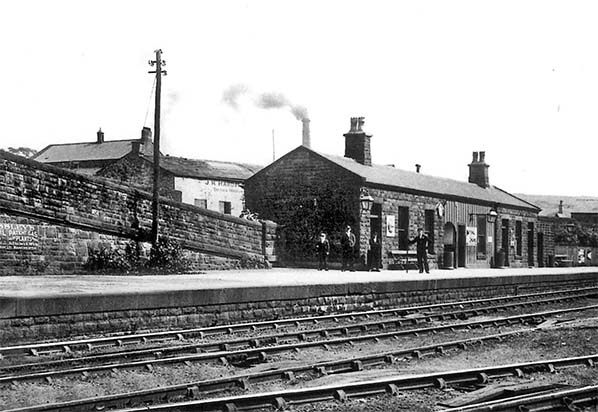 The single platform at Whitworth station, looking south-east across the sidings c1910. Despite its relative importance as an intermediate station, Whitworth had only a modest stone building with a pitched slate roof similar in style to that at Shawclough & Healey, in which the station offices and waiting facilities were found. The sheltered waiting area recessed into the building has been enclosed by a timber screen with door and window openings. Behind the sloping stone wall is the access from Hall Street overbridge.
Photo from Whitworth Historical Society and Jeffrey Wells collection   1935 street map
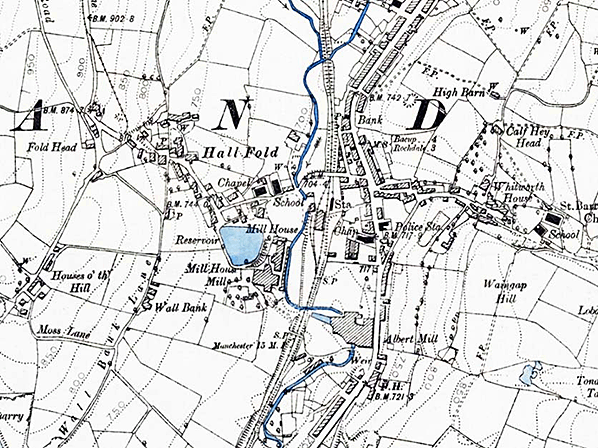 1890 1: 10,560 OS map. Whitworth station is south of the Hall Street overbridge with the platform and building on the up side. A signal box on the platform a short distance north of the station building has not been shown, although it is seen on the 1: 2,500 OS map of this time (not reproduced here). A loop and a siding are on the down side of the running line adjacent to the goods warehouse (not named). It will be seen that the station is well placed to serve the small industrial town of Whitworth which stretches along the floor of the River Spodden valley. A tramway, ending ¼-mile west of the station, brought stone downhill from Thorns Head Quarry to be dispatched to Rochdale by road, or further afield by rail; the stone reached Whitworth station by horse-drawn wagon from the tramway terminus at Hallfold. By 1910 the tramway had been dismantled
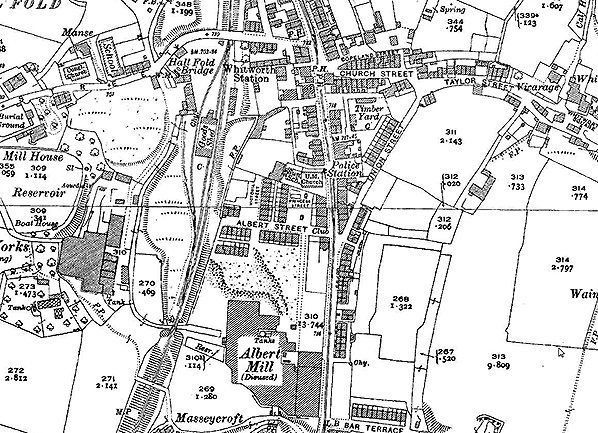 1930 1: 2,500 OS map. Whitworth station building (with its internal divisions) and platform are shown to the east of the running line and south of Hall Street bridge. The signal box that formerly stood on the platform north of the building has closed and been removed. Two goods loops are west of the running line, one passing through the goods warehouse, and there is a further siding to the west of the loops. Click here for a larger version 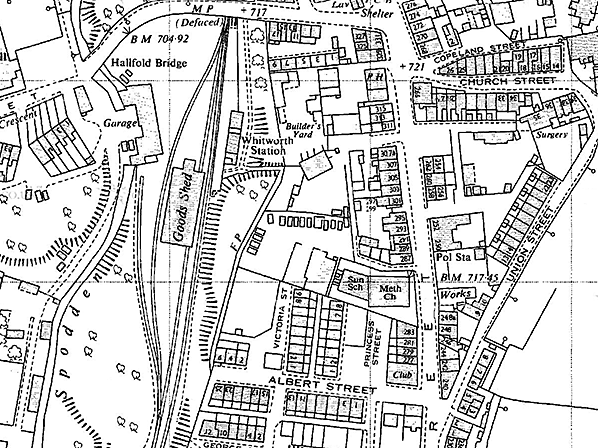 1960 1: 2,500 OS map. Although the station has been closed to passengers since the late 1940s it is still named, and it remains open for goods traffic. Click here for a larger version.
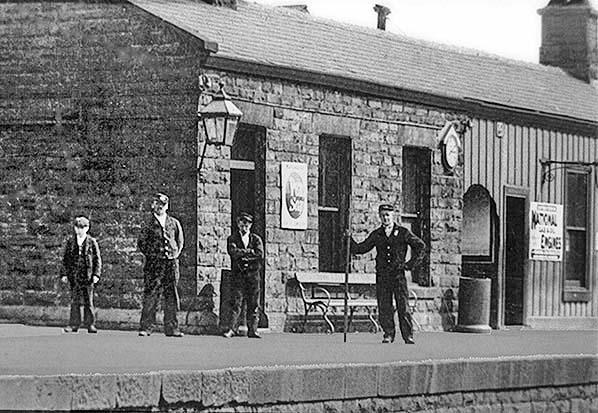 An enlargement of the c1910 photo that shows the station building. Station staff pose for the photographer. Detail of fixtures such as the lantern and clock are shown, as is the timber screen added on the right in front of the former recessed waiting area.
Photo from Whitworth Historical Society 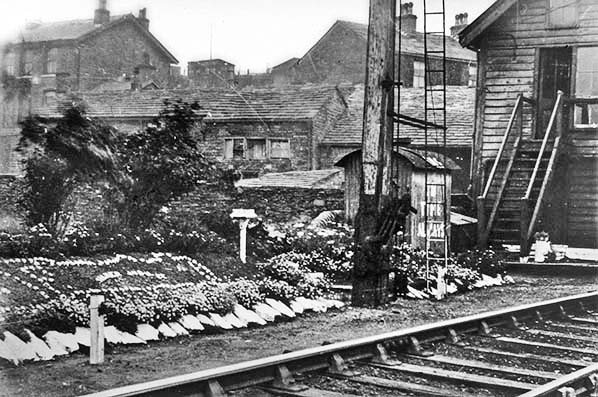 The signal box at Tonge End crossing midway between Whitworth and Facit. The small garden adjoining the box is of interest with the words ‘Silver Jubilee’ – presumably referring to 1935, the 25th year since the accession of King George V - and the outline of a locomotive created in pebbles. The corrugated iron cabin bears the reassuring words, ‘On time always’.
Photo from Whitworth Historical Society 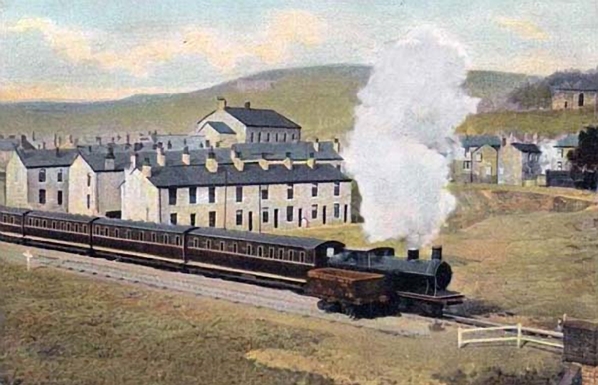 An artist’s impression of a train approaching the bridge over the River Spodden a short distance south of Whitworth station. A mineral wagon is standing at the end of the station’s long siding. The terraces of George Street and Albert Street are beyond the coaches, and the Methodist chapel rises above the general roofscape. Waingap Farm is on the slope, top right.
Painting by Hoyle 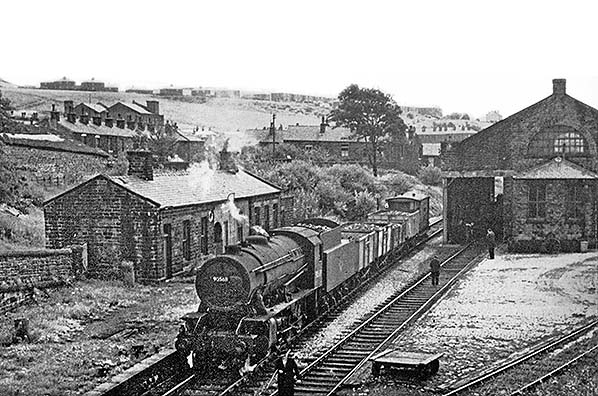 A northbound afternoon goods from Rochdale pauses at Whitworth station c1960: an unusual working for this train rarely runs beyond Shawclough & Healey. Although the platform is becoming unkempt the station building is in good order. A single siding still enters the goods warehouse. Commenting on this picture in 1962 P B Whitehouse opined, ‘somehow this rather ugly locomotive fits in with the drab Lancashire scene. One can easily imagine this station once occupied by brown coaches with the black horsehair seats of the LYR.’ No.90568 is a Riddles-designed WD loco built circa 1943. She was withdrawn on 31 January 1964 from 26A, Newton Heath shed, and cut up at Crewe works in March 1964.
Photo by Richard S Greenwood 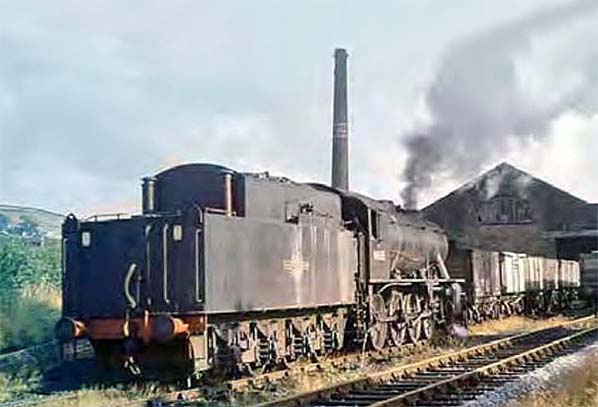 In August 1961 a WD ‘Austerity’ 2-8-0 is seen with a rake of coal wagons on the loop at Whitworth which passes through the goods warehouse. At this time the former Rochdale to Bacup branch continued only as far as Facit, the next station north from Whitworth, but in 1963 Whitworth became the northern terminus – and coal traffic was the mainstay of this station. This northward view includes the chimney of Orama cotton mill. The Riddles-designed loco was built between 1943 and 1945, and she remained in service until June 1964 when she was withdrawn from 26B, Agecroft shed, in Manchester. In December 1964 she was cut up by the Central Wagon Co, Ince, Wigan.
Photo by Richard S Greenwood
|
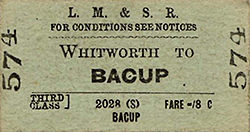 Whitworth station, like its neighbours at Broadley and Facit, was on a short level stretch of what was otherwise a steeply graded line. From Broadley, a mile south and at an altitude of 643ft, the line climbed continuously at 1 in 60 to Whitworth (698ft) after which the gradient increased to 1 in 50 to Facit, a mile north, and at 775ft.
Whitworth station, like its neighbours at Broadley and Facit, was on a short level stretch of what was otherwise a steeply graded line. From Broadley, a mile south and at an altitude of 643ft, the line climbed continuously at 1 in 60 to Whitworth (698ft) after which the gradient increased to 1 in 50 to Facit, a mile north, and at 775ft.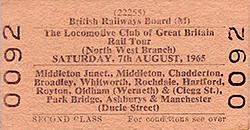 The main road between Rochdale and Bacup ran parallel, and close to, the railway and from as early as 1884 a tram route followed the road from Rochdale to Whitworth. Although the tramway, at first operated by steam struggled to pay it way and the route was cut back to Broadley, by World War 1 the tramway had been electrified and extended to Bacup and was competing effectively with the trains. After the war, trams and then buses continued to compete for passenger traffic, but in the 1930s the railway was still popular with Whitworth residents travelling to Rochdale to visit the shops. They would typically alight at Wardleworth from where they could walk the length of Rochdale’s two principal shopping streets (Yorkshire Street and Drake Street) and return home from Rochdale station, having generally walked downhill with their progressively heavier load of shopping. The 3d cheap day return fare on the trains compared favourably with 4d each way charged on the buses. The growing popularity of the cinema in the 1930s lured many of the Whitworth Valley’s residents to Rochdale on Saturdays, both to afternoon and evening shows; for their convenience, as intensive a train service was provided as the single-track route would permit.
The main road between Rochdale and Bacup ran parallel, and close to, the railway and from as early as 1884 a tram route followed the road from Rochdale to Whitworth. Although the tramway, at first operated by steam struggled to pay it way and the route was cut back to Broadley, by World War 1 the tramway had been electrified and extended to Bacup and was competing effectively with the trains. After the war, trams and then buses continued to compete for passenger traffic, but in the 1930s the railway was still popular with Whitworth residents travelling to Rochdale to visit the shops. They would typically alight at Wardleworth from where they could walk the length of Rochdale’s two principal shopping streets (Yorkshire Street and Drake Street) and return home from Rochdale station, having generally walked downhill with their progressively heavier load of shopping. The 3d cheap day return fare on the trains compared favourably with 4d each way charged on the buses. The growing popularity of the cinema in the 1930s lured many of the Whitworth Valley’s residents to Rochdale on Saturdays, both to afternoon and evening shows; for their convenience, as intensive a train service was provided as the single-track route would permit. 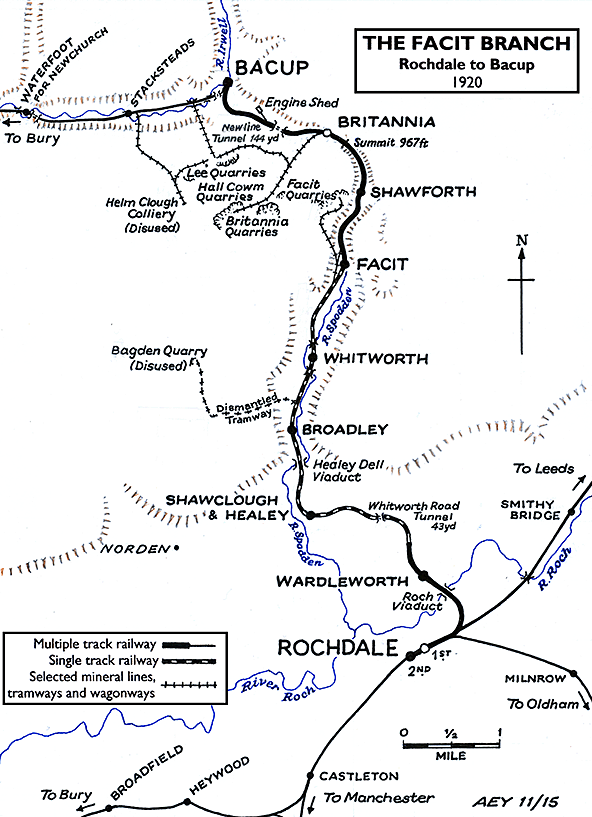
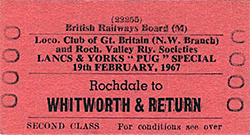 The remaining freight-only section between Rochdale and Whitworth closed on 21 August 1967, trains supplying Joe Taylor, the Whitworth coal merchant, having kept the route north of Shawclough & Healey operating in its final years. The tracks were removed by the end of the year. Whitworth station’s platform was still in existence in autumn 1971 in a state of disrepair but the building had been demolished. The OS 1: 2,500 map published in 1975 indicated that the coal merchant’s yard was still operating on the site of the former goods yard. Riddiough Court, a sheltered accommodation development in landscaped grounds, was built in 1988 on the station site. To the north of the station Hall Street still rises over the infilled former railway bridge, and beyond this the old trackbed to Facit is now used by a road called Cowm Park Way. On this stretch was Tonge End level crossing, where a signal cabin stood south of the crossing on the down (west) side with a crossing keeper’s cottage on the up side; this was a popular location with railway photographers, as will be seen below.
The remaining freight-only section between Rochdale and Whitworth closed on 21 August 1967, trains supplying Joe Taylor, the Whitworth coal merchant, having kept the route north of Shawclough & Healey operating in its final years. The tracks were removed by the end of the year. Whitworth station’s platform was still in existence in autumn 1971 in a state of disrepair but the building had been demolished. The OS 1: 2,500 map published in 1975 indicated that the coal merchant’s yard was still operating on the site of the former goods yard. Riddiough Court, a sheltered accommodation development in landscaped grounds, was built in 1988 on the station site. To the north of the station Hall Street still rises over the infilled former railway bridge, and beyond this the old trackbed to Facit is now used by a road called Cowm Park Way. On this stretch was Tonge End level crossing, where a signal cabin stood south of the crossing on the down (west) side with a crossing keeper’s cottage on the up side; this was a popular location with railway photographers, as will be seen below.
 Home Page
Home Page